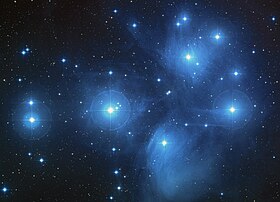Atlas (star)
 | |
| Observation data Epoch J2000 Equinox J2000 |
|
|---|---|
| Constellation | Taurus |
| Right ascension | 03h 49m 09.74258s |
| Declination | +24° 03′ 12.3003″ |
| Apparent magnitude (V) | 3.63 (3.84 / 5.46) |
| Characteristics | |
| Spectral type | B8III |
| U−B color index | −0.36 |
| B−V color index | −0.08 |
| Variable type | SPB |
| Astrometry | |
| Radial velocity (Rv) | 8.5±2 km/s |
| Proper motion (μ) | RA: +17.70 mas/yr Dec.: −44.18 mas/yr |
| Parallax (π) | 8.53 ± 0.39 mas |
| Distance | 431 ± 13 ly (132±4 pc) |
| Absolute magnitude (MV) | −1.82 |
| Orbit | |
| Primary | Aa1 |
| Companion | Aa2 |
| Period (P) | 290.984±0.079 d |
| Semi-major axis (a) | 13.08±0.12 mas |
| Eccentricity (e) | 0.2385±0.0063 |
| Inclination (i) | 107.87±0.49° |
| Longitude of the node (Ω) | 154.0±0.7° |
| Periastron epoch (T) | JD 2450583.0±1.9 |
|
Argument of periastron (ω) (secondary) |
151.9±2.2° |
|
Semi-amplitude (K1) (primary) |
26.55±1.41 km/s |
|
Semi-amplitude (K2) (secondary) |
36.89±0.22 km/s |
| Details | |
| Aa1 | |
| Mass | 4.74±0.25 M☉ |
| Radius | 7.9 R☉ |
| Surface gravity (log g) | 3.32±0.09 cgs |
| Temperature | 13,446±218 K |
| Rotational velocity (v sin i) | 280 km/s |
| Aa2 | |
| Mass | 3.42±0.25 M☉ |
| Radius | 3.2 R☉ |
| Surface gravity (log g) | 3.96±0.09 cgs |
| Temperature | 13,660 K |
| Ab | |
| Mass | 2.09 M☉ |
| Other designations | |
| Database references | |
| SIMBAD | data |
Atlas , designation 27 Tauri, is a triple star system in the constellation of Taurus. It is a member of the Pleiades, an open star cluster (M45). It is 431 light-years (132 parsecs) away, and is 3.92 degrees north of the ecliptic.
Nomenclature
27 Tauri is the star's Flamsteed designation.
In 2016 the International Astronomical Union organized a Working Group on Star Names (WGSN) to catalogue and standardize proper names for stars. The WGSN approved the name Atlas for this star on 21 August 2016 and it is now so entered in the IAU Catalog of Star Names.
Mythology
Atlas was a Titan and the father of the Pleiades sisters in Greek mythology.
Properties
Atlas is a triple star system, with the inner pair orbiting in under a year and the outer star orbiting in 260 years. The outer star, component Ab (sometimes component B, such as in CCDM and SIMBAD), has been resolved at a distance of 0.784″ from the unresolved spectroscopic binary. It is too close to have been assigned a spectral class, but has an apparent magnitude of 6.8, three magnitudes fainter than the combined magnitude of the closer pair. Its mass is estimate to be twice that of the Sun. In the WDS catalog, there are 8 other stars, ranging from B-I, which have been classed as companions of Atlas.

The inner pair have a well-defined orbit with a period of 291 days, a semi-major axis of 13 mas, and an eccentricity of 0.24. At an inclination of 108°, it is not thought to show eclipses. Although the two stars cannot be resolved, the primary, component Aa1, is calculated to be 1.6 magnitudes brighter than the secondary, component Aa2.
Low amplitude variability of the brightness of Atlas was tentatively detected in observations by STEREO and clearly detected by Kepler/K2. The light curve varies with several periods, the most prominent being 2.427, 0.7457 and 1.214 days.